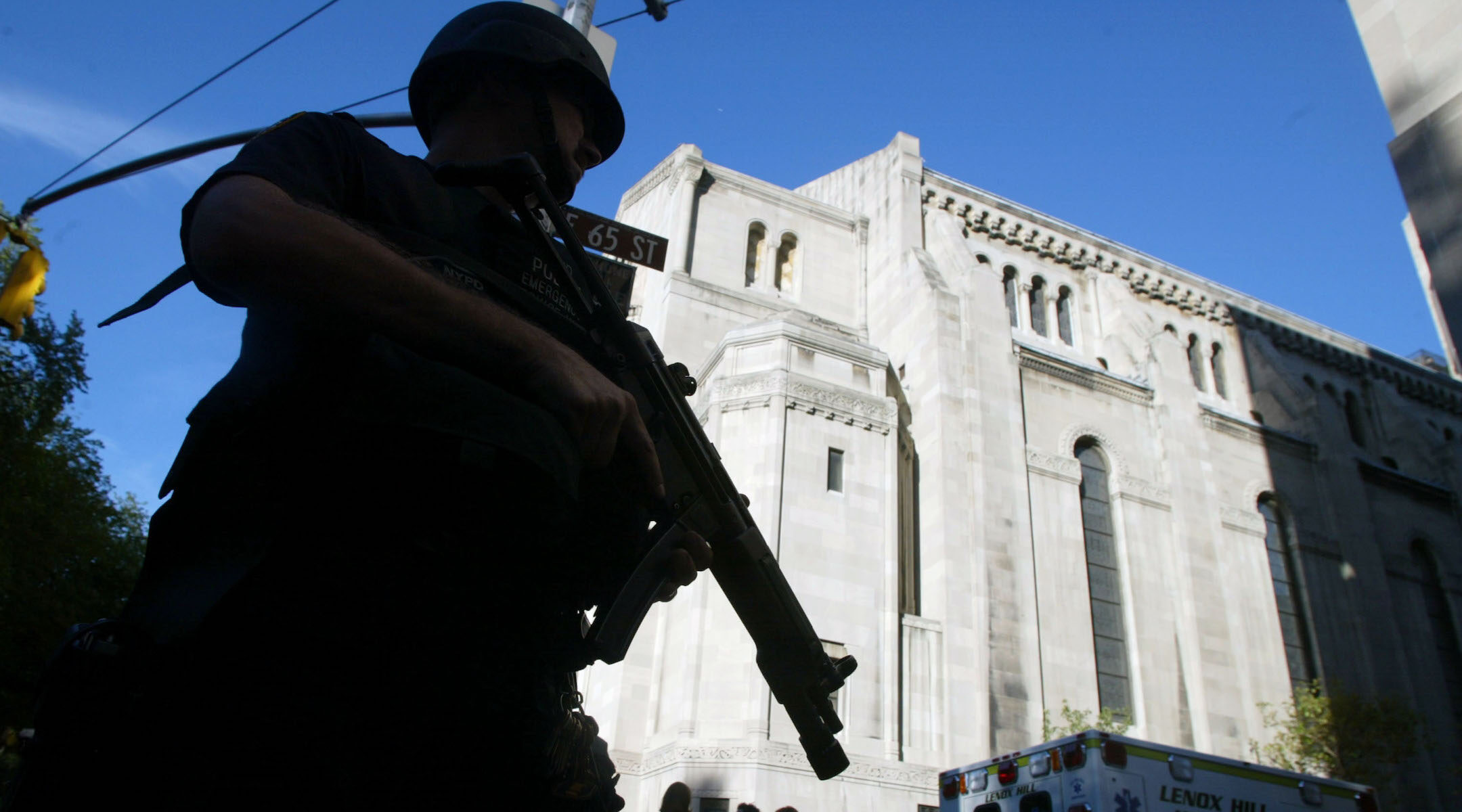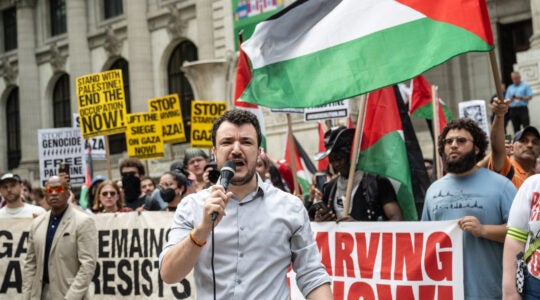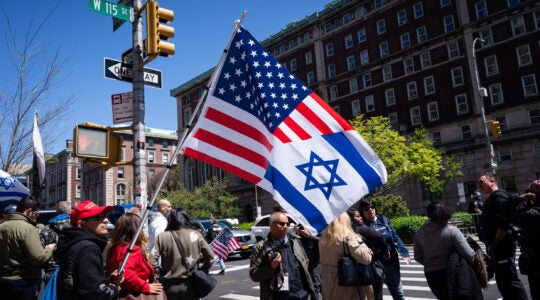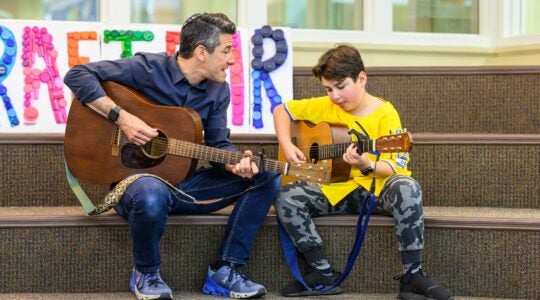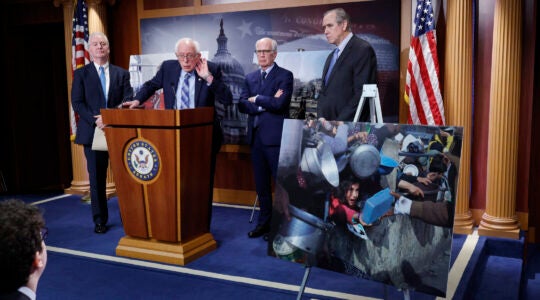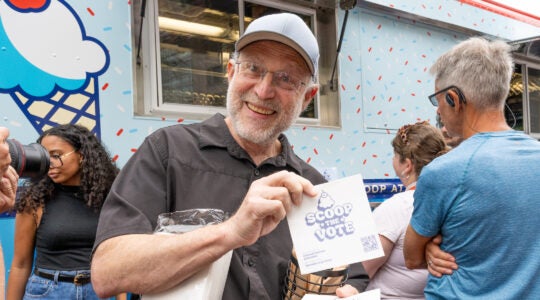NEW YORK (JTA) — Like many New Yorkers, Dara Horn remembers the weeks after Sept. 11, 2001, unfolding like a surreal nightmare.
Sitting in her Manhattan apartment, watching the second tower go up in smoke on live TV. Walking down streets plastered with posters bearing the faces of missing people. Crying every day for six months.
But it was four weeks after 9/11, on the festive Jewish holiday of Simchat Torah, that Horn saw with her own eyes how the attack was changing Jewish life in her city. Every year, police would close off a long stretch of West End Avenue in Manhattan, and synagogues of all stripes would gather for a night filled with crowds of Jews singing and dancing together.
That year, so soon after the attacks, the street party didn’t happen. Instead, Horn recalls each synagogue celebrating inside, on its own, often behind physical barriers.
“I just remember thinking on that Simchat Torah, are we ever going to dance outside again?” said Horn, the author of the just-published essay collection “People Love Dead Jews.” “Now there’s a cop car in the parking lot and security guards, and things like that, but that just became the norm.”
The sea change that swept over American life in the wake of 9/11 also washed over American Jews and their gathering places. It brought a new emphasis on physical security to Jewish institutions and, for Jewish communities, and what Horn described as “a rising baseline of fear.” In the past two decades, that shift in priorities has changed the way Jewish institutions look, how Jewish groups spend their money, and how rank-and-file Jews think about their place in the United States.
The 9/11 attacks came during an escalating wave of terrorism in Israel, leading Jewish leaders to draw a link between the two countries’ struggles. The attacks also spawned what the Anti-Defamation League called “a new anti-Semitic canard” blaming Israel, or Jews, for the attacks. Jewish organizations began pouring millions of dollars into security organizations. Millions more, in the form of government security grants, were given to synagogues and schools.
After the Pittsburgh synagogue shooting in 2018, followed by lethal antisemitic attacks in California and the New York City area, the emphasis on security only heightened. And now, 20 years later, even as some Jewish leaders and activists question the community’s reliance on police and security guards, others say it feels like it’s here to stay.
“We feel that this is certainly the most urgent priority, having the physical safety of our community protected so people can participate in Jewish life actively,” said Eric Fingerhut, CEO of the Jewish Federations of North America. “We are well aware that while we’ve made important progress, we’re not there yet.”
But he added, “We know that security is now the cost of doing business in the Jewish world. We’re not going back. It’s never going to go away.”
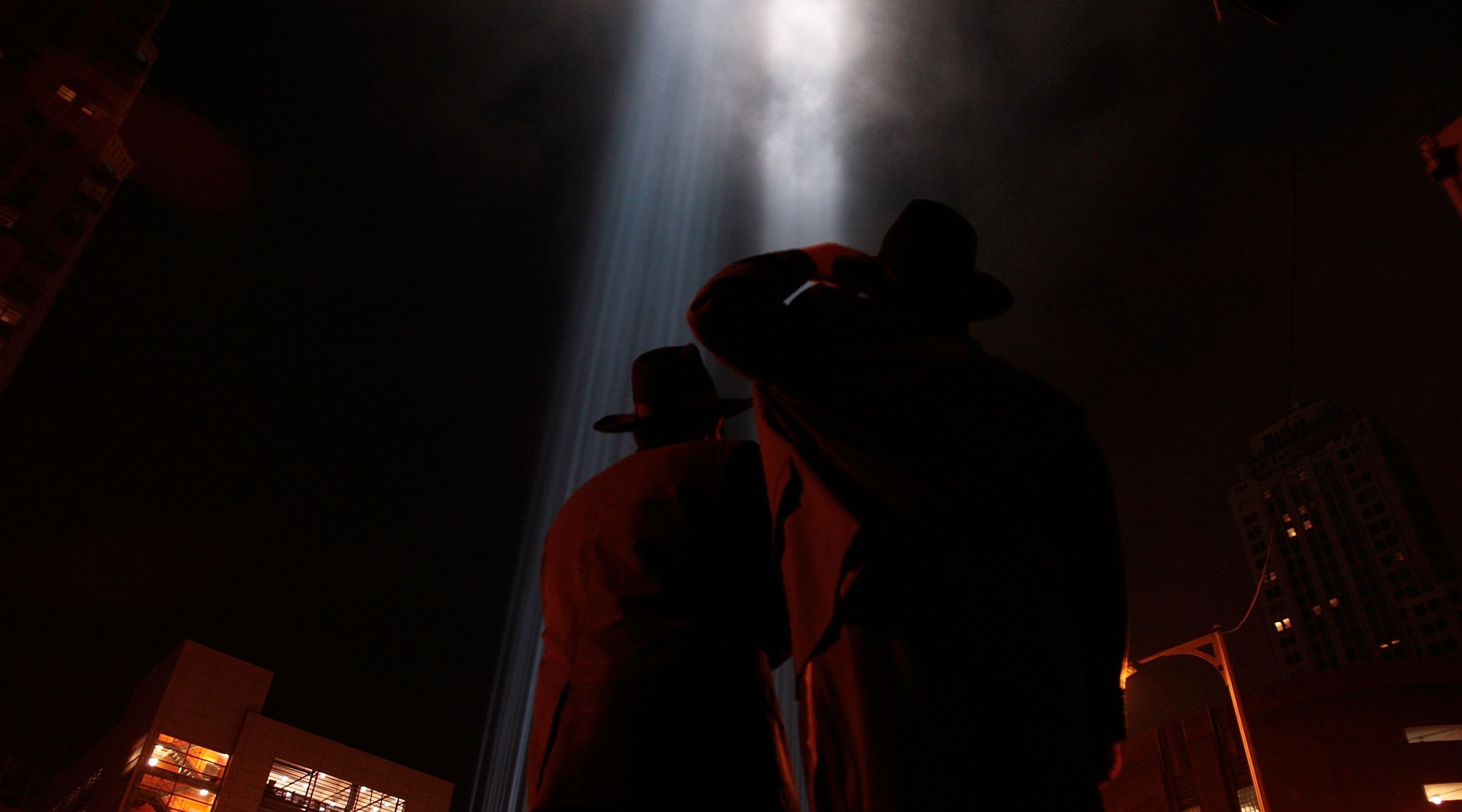
Two Orthodox Jewish men look up at the two columns of light, known as the ‘Tribute in Light’ memorial shine from lower Manhattan on September 11, 2007 in New York City (Chris Hondros/Getty Images)
A confident community is shaken — and begins to take action
In the days before 9/11, terrorism researcher Yehudit Barsky had traveled to Washington, D.C., to support a Jewish family that had survived a bus bombing in Israel and was now suing those who had funded the terrorist in American court.
But even as American Jews followed the terror attacks in Israel, she says, few American Jews took seriously the idea that a similar attack could happen here, even though there were worrying signs. In 1993, an attacker motivated partly by antisemitism had bombed the World Trade Center’s parking garage. The next year, an attacker shot at a van carrying Jewish teenagers on the Brooklyn Bridge, killing one, in an attack that was later classified as an act of terrorism.
“These were things that were going on, but unless you were a specialist, a lot of people thought, ‘Well, you know, we hope it doesn’t happen,'” said Barsky, who was then director of the American Jewish Committee’s Middle East and International Terrorism Division and is now a research fellow at the ISGAP think tank. “But sometimes you would see some kind of indication.”
After 9/11, Jews began paying more attention to the threat. “This was a time where we needed to be especially careful, especially vigilant,” Barsky said. That feeling was shared across major Jewish organizations.
In November 2001, the head of the Jewish federation system at the time, Stephen Hoffman, wrote in a letter to Sen. Joseph Lieberman that “our own institutions are particularly vulnerable to future terrorist threats in this country by virtue of our Jewish Affiliation.” He asked for “some modest government assistance” to help defray rising security costs.
Eight months after the attacks, in May 2002, Barsky organized a conference in Paris that would bring a delegation from the AJC together with the leadership of European Jewish communities in an unpublicized conference to discuss security and share best practices.
“I walked out believing that we would not have the same types of challenges that the European communities had,” said Paul Goldenberg, an attendee who at the time headed a hate crimes division in the New Jersey Attorney General’s office. “In many ways, I was wrong, because the Jewish communities of Europe were in many ways the canary in the [coal] mine.”
Hundreds of millions of dollars in security funding
Goldenberg would soon devote all of his attention to securing Jewish institutions. In 2004, two large Jewish umbrella groups founded the Secure Community Network, with the purpose of coordinating security across Jewish institutions — advising them on liaising with law enforcement, upgrading their physical security and training for emergencies. Goldenberg was its first director.
“The FBI and other law enforcement agencies were concerned that Jewish institutions would be subject to attacks and the law enforcement agencies at that time had no single agency or entity to work with within the Jewish community,” he said.
The Secure Community Network now has a budget of $7 million. In total, Fingerhut estimates that Jewish federations across the country spend some $30 million a year on security — and 45 of them have their own local directors of community security.
That’s all in addition to more than $100 million in homeland security grants Jewish institutions across the country received this year from the federal government to beef up their buildings — installing cameras or reinforcing windows and doors. Some states have their own additional grant programs. Federations and other groups are also pushing the government to double its total allocation for nonprofit security grants — from $180 million to $360 million.
“9/11 was the Big Bang event for extremists in general,” said Goldenberg, who is now a senior fellow at a Rutgers University institute focusing on security. He explained that al-Qaeda’s success in attacking the Twin Towers and the Pentagon inspired extremists across the ideological spectrum, serving as “an awakening for those that, maybe in the backs of their minds, were plotting and planning, and now find themselves with the opportunity to reach out to others that they feel are like-minded, and to plan and plot potential attacks.”
The 9/11 attacks also accelerated American Jewish efforts to portray Israel as a country with decades of experience fighting terror, and Israelis as exemplars of how to live daily life under the threat of terrorism. The Second Intifada, which had begun about a year earlier, was intensifying; just weeks before 9/11, a Palestinian suicide bomber killed 15 people in an attack on a central Jerusalem pizzeria.
After 9/11, U.S. police delegations to Israel led by Israelis and Jewish groups ramped up. And some American Jews wondered if they, like Israelis, would now be subject to a steady stream of terrorist attacks. That fear did not bear out.
“This was also during the intifada in Israel, so the first place my brain goes is, this is the first attack and now this is going to be happening every day,” Horn said, describing her mindset at the time. “There’s going to be pizzerias blowing up here.”
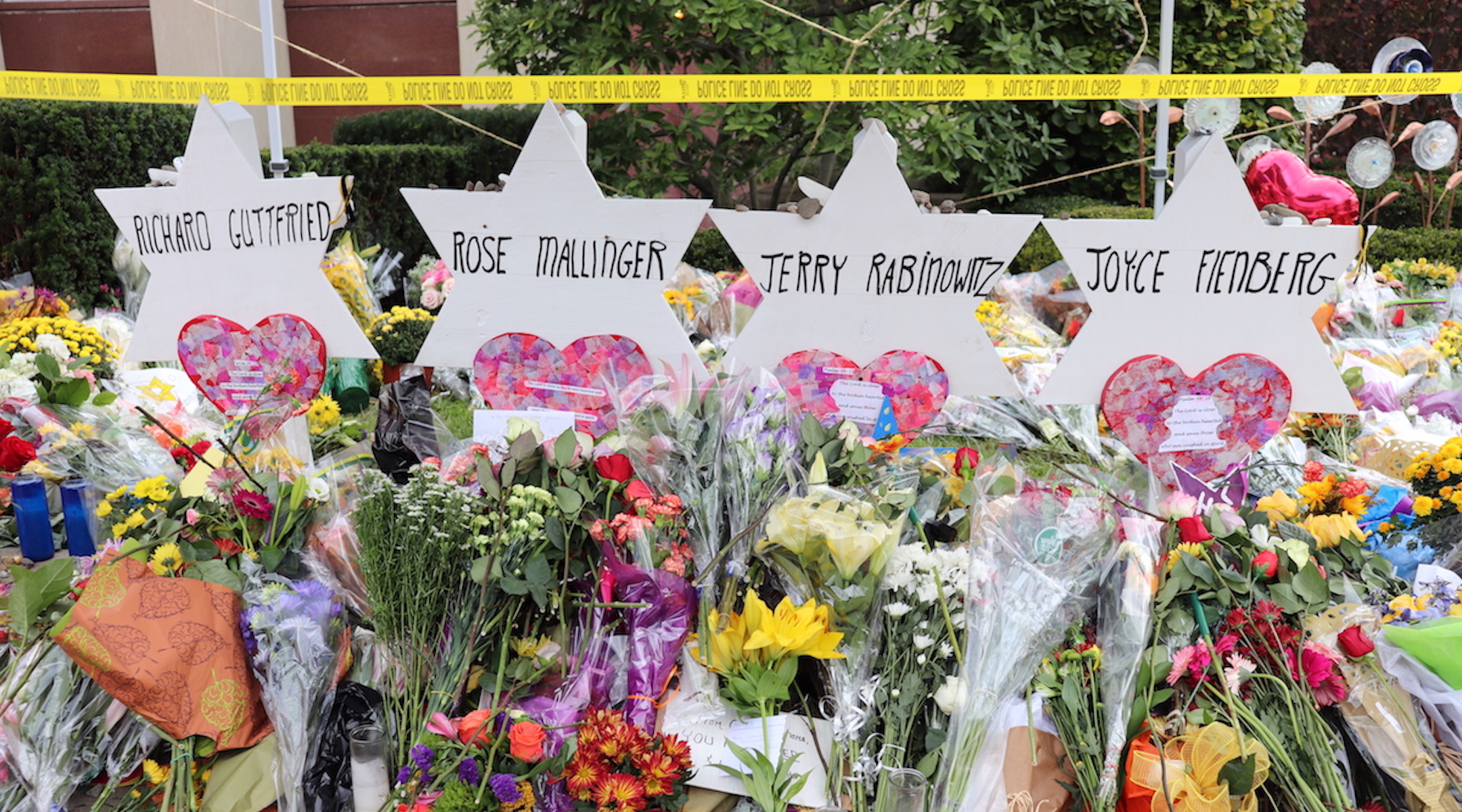
A memorial for the victims of the Tree of Life synagogue shooting in Pittsburgh. (Hane Grace Yagel)
From 9/11 to Pittsburgh
Over the years, according to former law enforcement officials, there were threats against synagogues from Islamic extremists that were caught in time. But terror groups like al-Qaeda were behind none of the four fatal attacks that struck Jewish establishments between October 2018 and December 2019.
The Pittsburgh synagogue attack in October 2018 was one of “two transformative events when we think about Jewish security in the United States over the last 20 years” said Mitch Silber — the first being 9/11. Silber, the former NYPD director of intelligence analysis, was motivated by the 2001 attacks to leave a career in finance and join law enforcement.
The Pittsburgh shooting was, for many Jews, almost as big a shock as 9/11. No longer did they face a threat born of terror groups based half a world away; now, a white supremacist American man had entered a synagogue and murdered 11 Jews at prayer.
The Pittsburgh shooting was the worst attack amid a yearslong rise in antisemitic incidents. Along with the synagogue shooting in Poway six months later, plus a string of antisemitic street assaults in New York City, it led synagogues, schools and community centers to apply for government security grants, debate whether to hire guards, and even consider whether congregants should be armed.
“The changes began right after 9/11 but certainly in our case accelerated dramatically in the last couple of years, especially since the Pittsburgh Tree of Life shootings,” Fingerhut said. “By time you fast forward to Oct. 27, 2018, which is the day of the Tree of Life attack, the question we ask ourselves is, what more do we need to do?”
Doubling down on security as antisemitism rises
Silber said that despite the trauma of 9/11, overarching communal action on security came later in New York City than elsewhere in the country. He said that’s partly because New York Jews tended to trust the NYPD, so they didn’t feel as much of a need to build out their own security staff.
But in 2019, following the attacks, umbrella communal groups decided to organize their own security organization as well. Silber was announced as the inaugural executive director of the Community Security Initiative, which now coordinates security for the country’s largest Jewish community.
“At some level the Jewish community in New York had such overwhelming confidence in the New York City Police Department that they didn’t feel that they needed an added security element to supplement it,” he said. “It was only because Pittsburgh and Poway were such gut-wrenching awful events that made people sick to their stomach and feel terrible that this change in strategy was catalyzed.”
The Society for the Advancement of Judaism, a Reconstructionist synagogue in Manhattan, began bolstering its security after the 2017 white supremacist rally in Charlottesville, Virginia and the Pittsburgh attack the next year.
The synagogue used to keep its doors open; now someone checks bags at the entrance. And it asks for a special donation from members to cover security costs. But Rabbi Lauren Grabelle Herrmann said the conversation about how much energy to devote to security, versus the synagogue’s other priorities, is ongoing.
“After Pittsburgh, some kind of response, of helping create a secure environment and place that people feel safe, was important, and I think it’s important that we continually reevaluate and have these conversations about those priorities, because to live as if any moment is frozen in time is challenging,” she said.
Herrmann and some other Jewish activists say more police protection or guards shouldn’t be the only way to protect Jews from violent hate.
“What happened in Pittsburgh shows that our fear of attack is very real and is in many ways grounded in real threats to our safety,” said Carin Mrotz, executive director of Jewish Community Action, a social justice group in Minneapolis. “As a community that has prioritized security to the detriment of our openness and inclusivity, we should ask ourselves if what we’re doing is the thing that will magically keep us safe.”
And even security officials who favor close cooperation with law enforcement say American Jews need not prepare for the intense fortifications that surround many European synagogues, such as thick walls, armed guards and metal detectors.
“Many people sometimes use the analogy of Europe,” said Michael Masters, the current CEO of SCN. “I do not believe that it would be acceptable, or we should accept as a Jewish community in North America, a condition which has our institutions looking like police institutions or military installations with high walls and barbed wire. Our institutions are as much a part of the North American landscape as any other house of worship.”
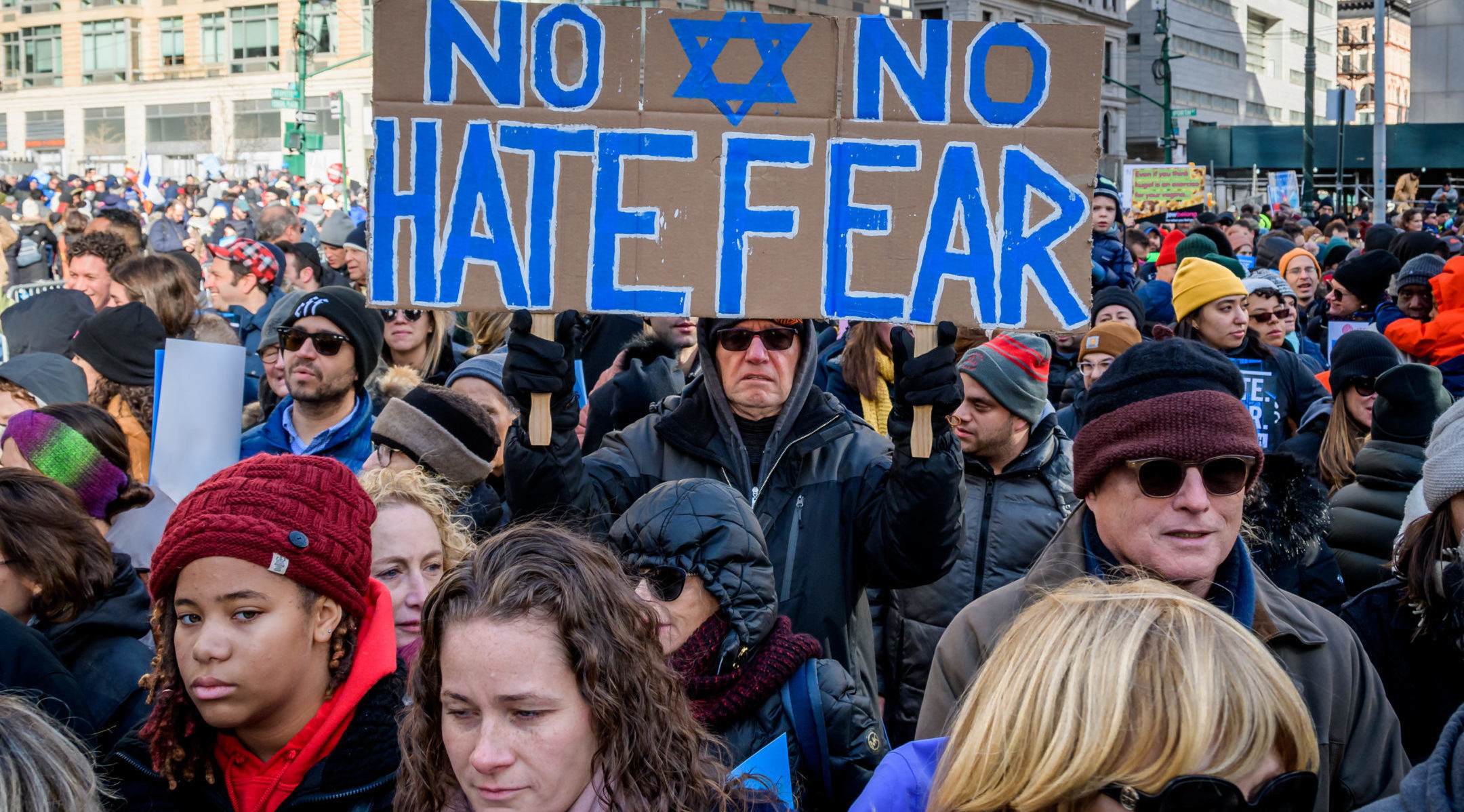
Thousands of New Yorkers convene at the “No Hate. No Fear” solidarity march against anti-Semitism in January 2020. The march followed a year in which attacks against Jews spiked. (Erik McGregor/LightRocket via Getty Images)
A changing threat
Along with waking people up to the threat of terror attacks in the United States, 9/11 birthed a new variant of an old antisemitic conspiracy theory: that Jews, or the Jewish state, were responsible for the attacks.
An ADL report from 2003 documented that white supremacists and other extremists on the far right and in the Musim world were spreading the lie that Israel or Jews more broadly orchestrated 9/11 in order to control the U.S. government or get it to take military action in the Middle East. The theory has endured as part of the 9/11 “truther” movement, which baselessly disputes the facts of the attack. It has even found its way into newer conspiracy theories like QAnon.
“These theories are poised to form the basis of a new anti-Semitic canard that will linger for decades and be used to demonize Jews and Israel,” the report said. “Anti-Semites are blaming Jews for the worst terrorist act committed and for its consequences, such as military conflicts. Allegations of Jewish culpability in the 9/11 attacks may even be used as justification for future acts of anti-Semitic violence.”
But even as the Jews-did-9/11 theory has persisted, experts on extremism appear to have shifted their attention from the Islamic extremist threats that were in focus after the attacks two decades ago. A report last year from the Department of Homeland Security identified white supremacists as the “most persistent and lethal” threat in the country. And the Jan. 6 insurrection drove home the danger of homegrown extremism.
“The ‘post-9/11’ era, where our greatest threats to national security were external, is over,” Michigan Rep. Elissa Slotkin, a former CIA officer who is Jewish, said in a statement in February. “It’s now extremists seeking to exploit internal divisions within our own country that pose the greatest threat.”
The shift from focus on 9/11 was also evident in a letter from ADL leadership sent last week ahead of the Jewish New Year. References to 9/11 were oblique — a commitment to helping absorb refugees from the Afghanistan War and concern that the recent Taliban victory means that country “seems poised to serve as a haven for Islamist extremists.”
But the letter focused on forms of antisemitism that have appeared to surge more recently — white supremacy, a wave of assaults surrounding the Israel-Hamas conflict in May, and a spike in Holocaust denialism and trivialization connected to the pandemic.
‘If they are not safe, neither am I’
ADL CEO Jonathan Greenblatt did address 9/11 directly in a CNN opinion piece, to apologize for the organization’s opposition to a Muslim community center in downtown Manhattan a decade ago. He wrote that the decision was “wrong, plain and simple,” amid a debate that included loud islamophobic voices.
“As we near the 20th anniversary of that tragic day, the need for healing remains,” he wrote regarding 9/11. “I hope that by righting this wrong, we can be better allies in the fight against the rise in anti-Muslim hate that is coming — and it is coming.”
Greenblatt’s essay is one sign that elements of the Jewish community are reconsidering policies Jewish organizations pursued in the years following 9/11. While the Pittsburgh attack led many institutions to hire guards and consider arming themselves, the racial justice protests last year led some to look again at the effects of requesting a police presence at their doors.
A recent study of the experiences of Jews of color found that 80% of respondents experienced discrimination in Jewish communal settings. The study reflected “prevalent trends about the places and moments when they are not fully embraced by the community or made to only bring a part of themselves to a program or congregation,” said Dalya Perez, a member of the research team that produced the study.
Rabbi Michael Adam Latz, senior rabbi of Shir Tikvah, a synagogue in Minneapolis, recalled what he suggested was a different model of finding safety following the Pittsburgh attack. His synagogue has invested in building relationships with nearby Christian and Muslim congregations, and following the shooting, members of those congregations stood in a circle around his synagogue in a show of solidarity.
“That’s what committed safety and security looks like, when we build deep, honorable, loving, difficult, challenging, sometimes exasperating but enduring relationships with our neighbors,” he said. “My friends in the mosque know that if they are not safe, neither am I. And they know that if I am not safe neither are they.”
Some Jews in New York also demur from focusing Jewish attention and energy on combating hate. Rabbi Mordechai Lightstone, who runs social media for Chabad.org, lives in Crown Heights, which has seen a series of antisemitic attacks over the years, and said he’d rather see Jews devoted to “the beauty and positivity and joy of Judaism.”
“While taking the realities of antisemitism seriously, our focus needs to be on Judaism itself,” he told JTA. “Fear can’t be what we use to drive our own Jewish engagement — let alone that of others.”
Discussions of physical security have become de rigueur at most synagogues in the United States, and many view physical security measures as a necessity. Sutton Place Synagogue in midtown Manhattan was graffitied with a swastika in 2017, and now invests in a robust security presence, said Rabbi Rachel Ain, though she did not go into further detail.
She said the congregation is on board with the security arrangements. She does not believe security expenses are a choice that deprives funding from other programming, but rather a necessary prerequisite that allows the synagogue’s work to happen.
“I would say it is a similar expense to how we understand our technological needs and making sure our roof is solid and the walls are painted,” said Ain. “We can’t just take care of the internal. We need to take care of the external.”
Dara Horn laments having to pass by a police cruiser and security guard when she goes to synagogue. She still remembers the carefree attitude Jews had more than two decades ago, when few foresaw something like 9/11 happening. But she also feels that the security measures are a reminder that the threats that became all too real that day are still here.
“I wish it hadn’t happened,” she said. “I’m not happy about it. There has been a dramatic change in the situation of the community and the way we think about security has really changed in 20 years, and that’s due to several different factors. I’m not happy about any of them, but not being happy about them is not the same as feeling that they weren’t necessary.”
JTA has documented Jewish history in real-time for over a century. Keep our journalism strong by joining us in supporting independent, award-winning reporting.
